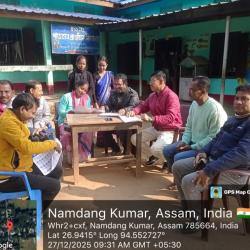Tibetan protest in Guwahati participated by the noted singer Zubin Garg and many others symbolize the rising awareness of freedom loving civil society in the Northeast that joins similar sentiments the world. Baichung Bhutia’s affirmation to stand with Tibetan people has certainly raised the tone of moral admonition against China’s repressive measures against Tibetans in the Northeast. The issue of Tibet’s freedom occupies a special place in an ethnically contested polity of India’s Northeast. It is special in the sense of emerging transnational movements of indigenous ethnic groups of the Northeast, all of whom now need to deal with the phenomenon of belonging and not-belonging both within the national boundaries and outside. Tibetan refugees and their claims of homeland resonate with this cultural politics of ‘stateless minorities’ in Southeast Asia and ‘indigeneity’ in Northeastern India. Most of the indigenous groups rooted in Northeastern societies engage themselves with the question of national identity, citizenship and territoriality, which also are issues in the affirmation of Tibetan national identity.
The right to self-determination of Tibetans has been historically accepted by the democratic state of India as opposed to Chinese policy of assimilation of Tibet and Tibetan culture within the national identity of the Chinese. If the self-definition and opinion of Tibetans is any criterion for determining whether or not they deserve to be independent, then the Chinese insistence upon Tibet as a part of China sounds a non-sequitur. The position of India since 50s Chinese crackdown on independence movement of Tibet has been that of a moral imperative that was first articulated by Jawaharlal Nehru. Chinese reaction to India’s acceptance of Tibetan refugees and their resettlement in Himalayan region has been a subject matter of repeated diplomatic dirges by China. It has also been an after dinner angst for dominant ethnic elites of China, who simply didn’t know how to take the civilizing influence of Tibet in the very ‘core’ of human existence. As they used Tibetan mocha imported from across the Quinghai-Tibet plateau in their ‘Lei Feng’ caps and watched Tibetan dragons flying towards the orb in their home made moccasin, they groped for an answer from the official media. The answer had been formulated during the horrendous ‘Cultural Revolution’ that proclaimed elimination of ‘five black classes’ (such as reactionaries, bad elements and rightists etc.) , which would certainly include the practitioners of Tibetan Buddhism and monasteries as ‘reactionary’. The prescription of Chinese ruling class for Tibet has been that of unification with other Chinese communities and acceptance of ‘Chinese Culture’, whatever that means. The idea of unification sought of Tibet with the mainstream Chinese society was formulated in terms of relinquishment of Tibetan Buddhism. Then, it mooted a grandiose idea of purifying the class background of Tibetan spiritual practices. Needless to say those diktats added to the counter-hegemonic strength of Tibetan Buddhism.
It is not only that many of the Northeastern States has a smattering of Tibetan people staying since 50s, but many of the Northeast Indian tribes and communities belong to Tibeto-Burman group of languages. Taking a global view, one can encounter the historical fact that out of many Tibeto-Burman groups settled in the greater Mekong region, a few of them migrated towards the Northeast. These include Monpas, Ahoms, Bodos and Garos migrating at different points of time and settled in a variety of locations. But, culturally and linguistically, one can trace connectivity throughout greater Mekong region to Tibet to Sikkim, Arunachal Pradesh, Meghalaya and Assam, the traces of which bring back forgotten histories of migration. The delicate and fine ethnic and cultural differences between some of these communities and Tibetans can be attributed to forces of cultural evolution, which still conserves many of the original cultural practices, idioms and beliefs. This can be understood from migration of ideas, truths of life, images of soul, taboos and many other artifacts of belief that spread from Tibet to all the four sides of the neighbourhood. The Tibetan struggle for independence is a legitimate historical claim that can transcend Chinese political boundaries in order to join up with other stateless minorities across Southeast Asia.
The skit organized by children at the site of protest in Guwahati on 8th April displayed Chinese crackdown and subsequent repression of dissenters. The repression has been made so systemic by China that eight years old Karmapa had to flee to India in early 2000. The Chinese authorities, by force, intended to stop Karmapa from receiving wisdom from Karma Kagyu tradition as well as his preachings to followers. It was a well-thought out attack on continuance of Tibetan knowledge system and replace it by a rash of strikes with a tailor made Chinese worldview of work and profit. Although there is no such parallel between India’s mainland and Northeast, yet there is a sense in which affirmation of distinct indigeneity of many of the Northeastern communities finds a common ground with the Tibetan cause.
The right to self-determination of Tibetans has been historically accepted by the democratic state of India as opposed to Chinese policy of assimilation of Tibet and Tibetan culture within the national identity of the Chinese. If the self-definition and opinion of Tibetans is any criterion for determining whether or not they deserve to be independent, then the Chinese insistence upon Tibet as a part of China sounds a non-sequitur. The position of India since 50s Chinese crackdown on independence movement of Tibet has been that of a moral imperative that was first articulated by Jawaharlal Nehru. Chinese reaction to India’s acceptance of Tibetan refugees and their resettlement in Himalayan region has been a subject matter of repeated diplomatic dirges by China. It has also been an after dinner angst for dominant ethnic elites of China, who simply didn’t know how to take the civilizing influence of Tibet in the very ‘core’ of human existence. As they used Tibetan mocha imported from across the Quinghai-Tibet plateau in their ‘Lei Feng’ caps and watched Tibetan dragons flying towards the orb in their home made moccasin, they groped for an answer from the official media. The answer had been formulated during the horrendous ‘Cultural Revolution’ that proclaimed elimination of ‘five black classes’ (such as reactionaries, bad elements and rightists etc.) , which would certainly include the practitioners of Tibetan Buddhism and monasteries as ‘reactionary’. The prescription of Chinese ruling class for Tibet has been that of unification with other Chinese communities and acceptance of ‘Chinese Culture’, whatever that means. The idea of unification sought of Tibet with the mainstream Chinese society was formulated in terms of relinquishment of Tibetan Buddhism. Then, it mooted a grandiose idea of purifying the class background of Tibetan spiritual practices. Needless to say those diktats added to the counter-hegemonic strength of Tibetan Buddhism.
It is not only that many of the Northeastern States has a smattering of Tibetan people staying since 50s, but many of the Northeast Indian tribes and communities belong to Tibeto-Burman group of languages. Taking a global view, one can encounter the historical fact that out of many Tibeto-Burman groups settled in the greater Mekong region, a few of them migrated towards the Northeast. These include Monpas, Ahoms, Bodos and Garos migrating at different points of time and settled in a variety of locations. But, culturally and linguistically, one can trace connectivity throughout greater Mekong region to Tibet to Sikkim, Arunachal Pradesh, Meghalaya and Assam, the traces of which bring back forgotten histories of migration. The delicate and fine ethnic and cultural differences between some of these communities and Tibetans can be attributed to forces of cultural evolution, which still conserves many of the original cultural practices, idioms and beliefs. This can be understood from migration of ideas, truths of life, images of soul, taboos and many other artifacts of belief that spread from Tibet to all the four sides of the neighbourhood. The Tibetan struggle for independence is a legitimate historical claim that can transcend Chinese political boundaries in order to join up with other stateless minorities across Southeast Asia.
The skit organized by children at the site of protest in Guwahati on 8th April displayed Chinese crackdown and subsequent repression of dissenters. The repression has been made so systemic by China that eight years old Karmapa had to flee to India in early 2000. The Chinese authorities, by force, intended to stop Karmapa from receiving wisdom from Karma Kagyu tradition as well as his preachings to followers. It was a well-thought out attack on continuance of Tibetan knowledge system and replace it by a rash of strikes with a tailor made Chinese worldview of work and profit. Although there is no such parallel between India’s mainland and Northeast, yet there is a sense in which affirmation of distinct indigeneity of many of the Northeastern communities finds a common ground with the Tibetan cause.
- Add new comment
- 9557 reads










Comments
Add new comment